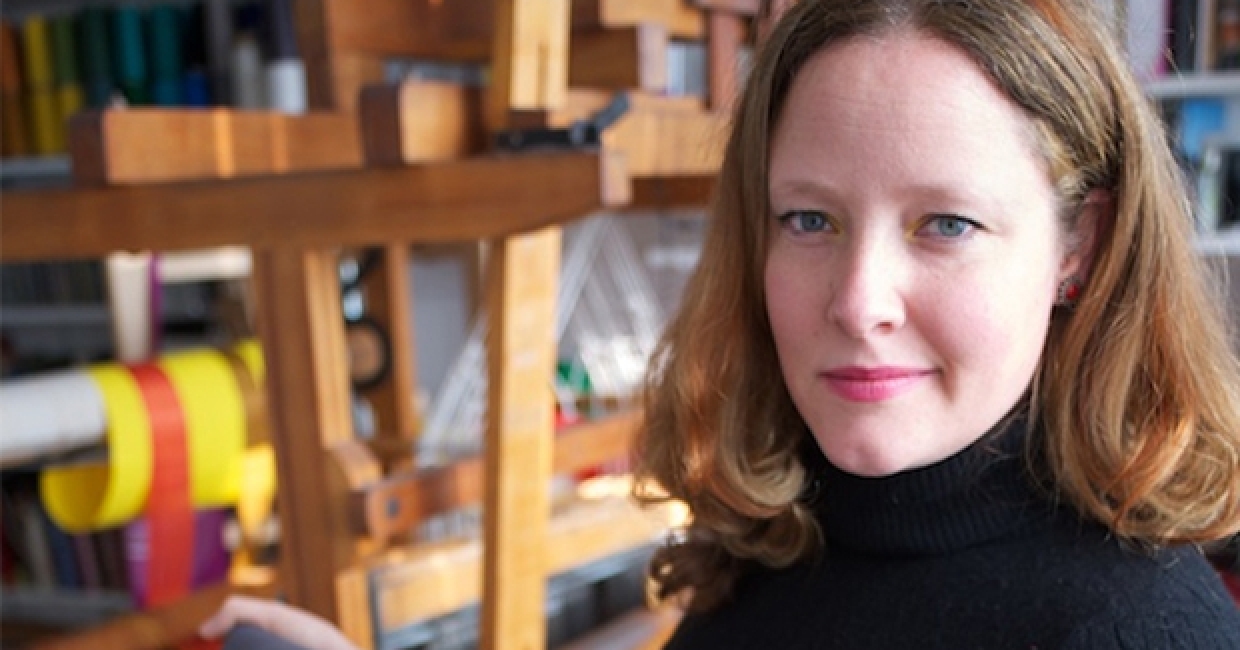With a colourful portfolio and a bright personality to match, Ptolemy Mann is thriving. Katie Sherry spoke to Ptolemy about the inspiration and ambition behind her work ...
Immediately after completing a Masters degree in Woven Textiles at the Royal College of Art – preceded by a Bachelors degree in Textile Design at Central Saint Martins – Ptolemy opened her first studio in 1997. Since then, a successful business in textile art, design and colour consulting has been built from scratch – and it is clear that Ptolemy’s signature style has taken her far and wide.
Utilising the traditional Ikat dyeing technique, Ptolemy’s work consistently features geometric lines with great emphasis on bold, graduating colour tones. By establishing a signature style, Ptolemy is able to create a recognisable quality in all areas of her work.
“Although it can be difficult balancing the elements of the craft and commercial worlds, it is also quite stimulating to be able to work in very different fields,” Ptolemy explains.
“What I have essentially done is master a well-known, traditional technique and modernise it”
“To me, a cushion that I have designed for John Lewis – which has then sold for around £50 – is just as beautiful as a one-off art piece that is more expensive. Although they are very different things, both have a shared quality and are a thing of beauty. It is important to feel that way about everything you create.”
Ptolemy’s portfolio features a wide range of projects – from one-off art pieces to fabrics for corporate and private commissions. Her first step into commercial design was marked by a collaboration with leading rug manufacturer, Christopher Farr. In designing a range of high-end rugs, Ptolemy saw her signature as an artist translate into commercially viable products.
Despite continuing to hand-weave one-off pieces as a craftsperson, Ptolemy’s career as a designer is now moving towards digitally-printed linen and upholstery.
“Digital printing techniques have moved forward in recent years, creating a new market for furnishings,” Ptolemy claims. “New technology has resulted in digitally-printed fabrics becoming more durable and cost effective.”
With her polished, contemporary designs receiving great acclaim – culminating in a 2011 Homes & Garden Design Award – Ptolemy’s work has garnered a lot of interest from industry professionals and consumers alike.
“It is the design-led element of my work that people are responding to,” she says. “The hand-weaving and Ikat dyeing methods that I use have been around for thousands of years. What I have essentially done is master a well-known, traditional technique and modernise it.”
Undeniably, one of the most striking elements of Ptolemy’s work is her use of colour. Favouring bold, bright tones in her designs, Ptolemy uses strong, saturated colour as her trademark.
“It is important that any piece I create still has value and beauty in 20 or 30 years’ time”
As a colour consultant, Ptolemy focuses on how colours interact with each other and what effect this has on the person viewing the piece. She claims that people are intuitively drawn to bright or neutral colour tones depending on mood or outside circumstances. When referencing the current economic downturn, for example,
Ptolemy argues that people are more likely to instinctively prefer vivid hues in an effort to create a more positive atmosphere.
“People love colour and have a very personal reaction to it, which can be quite emotional,” she explains. “Colour is an easy and cheap way for people to cheer themselves up, and as such can be a very powerful tool.”
Owing to the personal relationship that people have with colour, a huge industry has developed around it. The financial investment into colour trend prediction through the use of forecasters emphasises its importance in the world of design.
“Colour essentially drives the whole business,” Ptolemy explains. “Although the designs of products do not often change, colour is an easy way of frequently renewing collections. With so many tonalities available, colour offers infinite possibilities.”
Although products have the potential of being updated at regular intervals, Ptolemy aims to create pieces that stand the test of time. “What I am interested in is making beautiful products that have longevity,” she says. “It is important that any piece I create still has value and beauty in 20 or 30 years’ time.”
The growing interest in Ptolemy’s work has opened several doors of opportunity – one of which was the chance to design a fabric for leading trade exhibition, Interiors UK, in 2012. The event housed a Fabric Pavilion decorated with Ptolemy’s design.
The canopy, which framed the edge of the Fabric Pavilion, featured a digitally-printed design in Ptolemy’s signature modern Ikat style. The design, Vortex, is a single large-scale repeat across 140cm, and features geometric lines in three bright, strong colourways.
Vortex, alongside another of Ptolemy’s designs, was also upholstered onto bespoke studio couches from leading furniture manufacturer, Ercol. The result was an eye-catching, free-standing space.
In addition to creating a specially-designed fabric for the Fabric Pavilion, Ptolemy was invited to speak during Interior UK’s seminar programme. Entitled The Architecture of Cloth, Colour and Space, the talk explored Ptolemy’s work as an artist, designer and colour consultant.
The talk was inspired by Ptolemy’s retrospective exhibition of the same name, which toured the UK throughout 2012.
This story was first published in Furniture News, March 2012.










